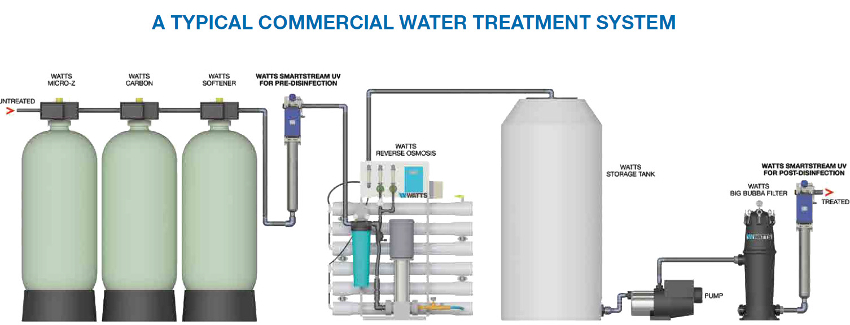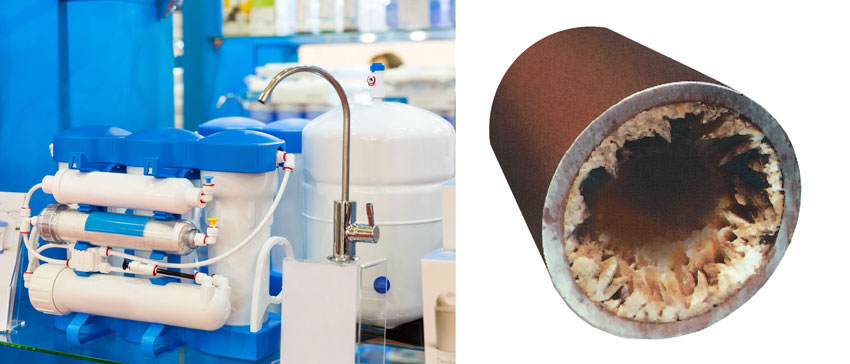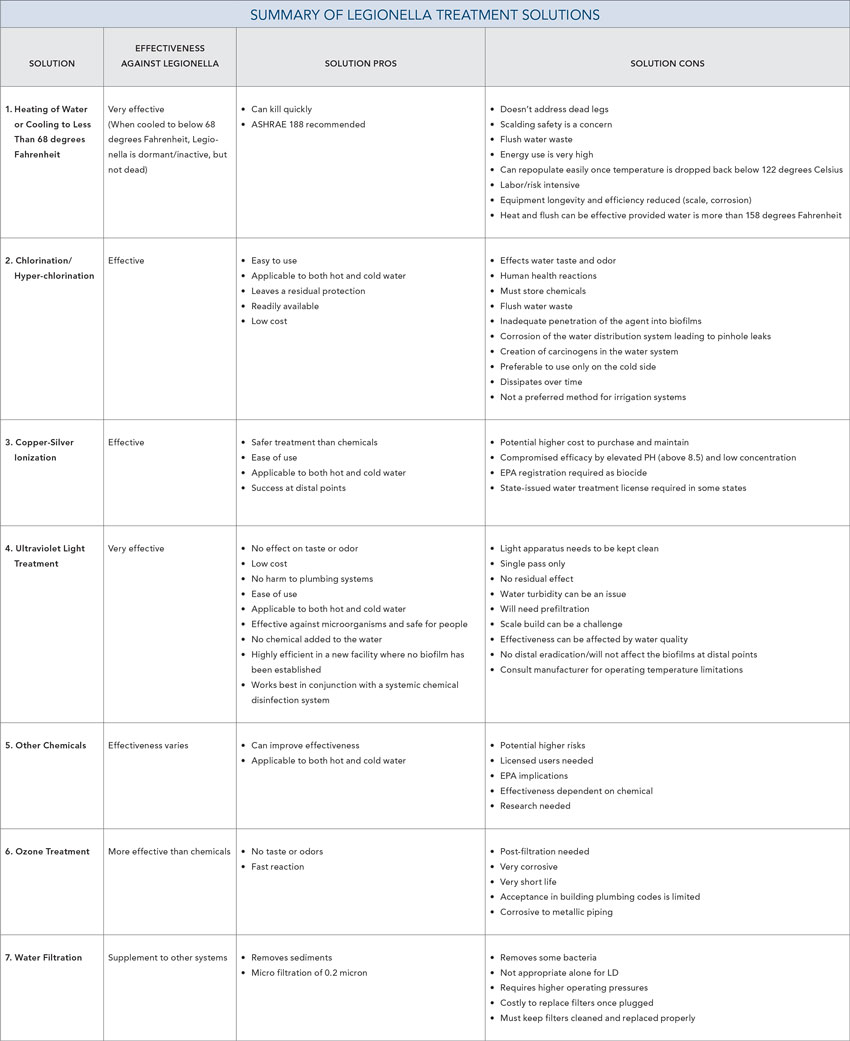Solutions to Help Control Legionella
Solution 3: Copper-Silver Ionization
The use of a carefully engineered copper-silver ionization system is particularly well suited for buildings where the intent is to avoid or reduce the amount of chlorine being used in potable water. Like chlorine treatments, it can be used in either hot or cold portions of the water system, but unlike chlorine, it has almost none of the negative side effects.
The process of copper ionization was developed by the National Aeronautics and Space Administration (NASA) many years ago as a way to purify drinking water for astronauts in the Apollo Space Program. It is available for earthly use too based on employing positively charged ions from copper and silver plates. These positive ions form an electrostatic bond with negative sites on the cell walls of bacteria. The interaction breaks down the biofilm of the bacteria cell and kills it in the process. Depending on the conditions of the water and the bacteria, the amount of time it takes for the biofilm to be penetrated can vary, but this system has become to be regarded as one of the most effective treatment systems besides heat treatment. Incorporating a system that creates an EPA-approved level of 1.3 parts per million (ppm) of copper ions and 0.1 ppm of silver ions has the benefit of providing a consistent, continuous treatment that can be monitored and maintained readily. Typically, the ionization process requires a low-voltage current to free the copper and silver ions into the flow of water, but it is not a particularly significant amount of energy used. The ions become sacrificial in that they are neutralized after the purification process. Therefore, the metal plates that produce the ions need occasional replacement.
The pros of a copper-silver ionization solution include a safer treatment of water than chemical additions such as chlorine. It has also been proven to effectively control legionella and other pathogens in cold and hot water systems. It is a federal EPA-approved system that requires very little square footage to install and operate. The cons include potential higher costs to purchase and maintain the system and the possibility that some local jurisdictions may not recognize it as an approved system.
Solution 4: Ultraviolet Light Treatment
In water systems where eliminating the use of chemicals is preferred, another option is to disinfect the water supply with ultraviolet (UV) light. In this type of system, an electric lamp is used that is specifically designed to generate UV radiation, specifically UV-C radiation that has germicidal properties for disinfection. The lamp is designed to emit nearly monochromatic UV-C radiation in the optimum range for absorption by nucleic acids in the cells of microorganisms. The low-pressure lamp (commonly mercury vapor in the shape of a small fluorescent tube) is mounted in a waterproof housing and inserted directly into the stream of supply water, making it an “in-line” system. As the water passes by the lamp, the UV light disrupts the genetic DNA material of any microorganisms, including bacteria, in the water. Sometimes referred to as UV sterilization, this is a simple and rapid physical process that causes molecular rearrangement of the genetic material within microorganisms. This quickly inactivates the microorganisms by destroying their ability to multiply, grow, and ultimately infect.

UV light can be used to control bacteria and viruses as part of an overall commercial water treatment system or in residential settings too. Here, the UV component provides pre-disinfection after a water softener and post-disinfection as the final step before water distribution.
A centralized UV disinfection system can be highly effective at providing protection against microbiological contamination in water. It can be added as an integral component of a full commercial water treatment system. In this case, UV disinfection must be used as a last step in the water treatment system, just before dispensing. UV can also be used as a pre-disinfection for reverse osmosis systems to protect the membranes from microbial contamination. The effectiveness of the disinfection depends on the UV dose level delivered, keeping in mind that different organisms require different UV dose levels to be inactivated. These systems are attractive not only because they can be very effective at killing legionella bacteria but also because they are fairly simple to use and operate. The dose produced can easily be set to suit the target organism(s) by adjusting the UV system’s flow rate. Connected to a power source, they produce the UV light that is projected onto the incoming water without the need for any chemicals to be handled or added to the water. For large systems, they are commonly completely enclosed for safety to prevent any accidental UV exposure to people. They also typically have sensors indicating their use and performance levels and can be specified to operate efficiently by only turning on when there is actual water flow in the supply line. They do require monitoring to be sure they are performing properly in a continuous state but only need minimal maintenance.
The pros of an ultraviolet light treatment solution are centered on the fact that no chemicals are involved. That means there are no chemicals to store or add, nothing to affect taste, and nothing that reacts with any other impurities in the water. The lack of chemicals also removes the potential for any harm being done to piping and equipment caused by chemical treatments. The cons can include the amount of energy needed to generate the light on a continuous basis, although some units are available that shut off if water is not flowing. The light apparatus needs to be kept clean so the light remains effective, and the water needs to be clear, not turbid. It should be remembered that this is a single-pass treatment at the lamp; there is no residual treatment further on in the system. If warranted, other treatment such as heat could be incorporated elsewhere in the system.
Other Solutions
In addition to the four common systems discussed thus far, there are some other strategies that can be incorporated. These may be appropriate for portions of systems or for some specific reason but are worth mentioning here for consideration when warranted.
Other Chemicals
There are some alternatives to chlorine but with a variety of results and effectiveness in regards to legionella. We have already discussed that mono-chloramines (NH2Cl) are used by some municipal water sources because they are seen as a safer alternative to straight chlorine. It also has a much lower tendency to convert organic materials into chlorocarbons, such as chloroform and carbon tetrachloride, which can cause their own health risks and detrimental effects on the plumbing. Nonetheless, they still carry some notable concerns, not the least of which is that NH2Cl is listed as a carcinogen and mutagen. Hence, it is typically used in very low concentrations, offering a very stable additive that does not dissipate as quickly as straight chlorine does. So while this chemical may already be present in municipal water and can penetrate a wide range of biofilms in microorganisms, it does bring with it the risk of some harm to people or plumbing if mixed improperly or if it infiltrates at too high a level.
Chlorine dioxide (ClO2) is a neutral chlorine with a chemical structure and behavior that is very different from basic chlorine. It has a very high water solubility and remains dissolved as a gas in the water, even at low temperatures. It is sometimes used in smaller secondary distribution lines that have no galvanized piping that could be affected by it. It has the pros of being an EPA-approved biocide that performs better than chlorine when the water pH level is above 7. It also works well in all temperatures of water and bacteria does not seem to grow resistant to it. On the cons side, a licensed individual with a specific license is needed to operate this system since the material is considered toxic and can become volatile if not stored correctly. Its effect on legionella is slow, requiring a prolonged exposure to show any reduction. Reactions with organic material in the water or corrosion scale on the piping can cause the chlorine dioxide to convert to its by-products (chlorite and chlorate), which may pose health risks.
In general, while both of these chlorine alternatives provide some advantage over straight chlorine, they also bring some other issues that need to be carefully assessed before they are used as part of a full water management program.
Ozone Treatment
Another alternative to chlorine is the use of ozone (O3) which is a naturally occurring clear-bluish gas with a distinctively fresh smell. Ozone has been shown to be more effective against bacteria and viruses than chlorination while eliminating any taste or odor issues. It is introduced into the water stream either by bubbling it up from the bottom of water tank or by using a Venturi tube to pull the ozone into the water. As an enhanced version of oxygen (O2) it has oxidation properties that help reduce some concentrations of minerals and organic particles too. This can cause insoluble particles to form in the water, which means that some form of post-filtration is needed to keep the water clean. Nonetheless, even with the added filtration, it is generally an effective and economical means to treat water.
Water Filtration
Water filtration is a common approach to remove contaminants from water. It is appropriate to use regardless of the water source to help prevent contamination of the building water system from incoming water. Filtration is a good supplement to help assure overall water quality, but it will not, by itself, address the control of legionella. It can, however, be very effective at helping other systems work properly. That is because one of the biggest benefits of water filtration is the removal of sediments and some minerals from the water. When those are not filtered, they can build up in the piping and equipment in the form of scale, which can restrict water flow or interfere with the proper operation of other equipment. Further, filtration can help with reducing overall bacteria growth, in part because of the reduction of scale where it can harbor, and in part from filtering some of it directly out of the water.
As an example of the interaction between filtration and other water treatment system components, a study performed in the mid-1990s at the VA Medical Center in Pittsburgh tested the effects of UV radiation at the point of use on showers in the facility. The UV treatment appeared to work well at first but then became less effective. It discovered that the incoming hard water was depositing scale on the UV lamp and reducing the amount of UV light that was passing into the water. Once the lamp and housing were cleaned and filters installed to address the hard water, the problem went away, and the UV system became a very effective means of controlling legionella at the facility.

Water filtration is an effective supplement to some of the other solutions discussed and can keep them functioning properly. In particular, it can prevent the buildup of scale as seen in the pipe shown above.
Circulation Controls
Among the common approaches to protecting water quality in a water supply system, the use of backflow preventers is typical. Backflow systems are essentially a series of plumbing control valves that prevent the reverse flow of polluted water from entering into the potable water supply due to back-siphonage and or backpressure. Some municipal water systems will require backflow systems, particularly on large water users such as health-care facilities, since it is in the interest of public safety and health to do so, especially if there is any chance of infectious bacteria entering the water system. Therefore, including backflow preventers can be part of a preventive control measure in a water management program. While important, it does not provide any treatment of the water; rather, it simply helps assure that the water is flowing in the proper direction to help maintain good water quality.
Design Considerations
In addition to solutions the design of the premise plumbing should be extensively reviewed. Plumbing systems can be complicated, especially within a hospital. A majority of hospitals are older structures that have been added on to and renovated multiple times. This increases the complexity of water systems. Some design methods include continuous recirculation of domestic hot water; high water temperature is maintained throughout the main waterway, with tempering valves at all points of use.
Yet, there are still challenges. Consider first that many large facility domestic water systems can contain many thousands of gallons of water (U.S. hospitals are water hogs, using an average of 570 gallons of water per staffed bed). That’s a lot of water. Consider, too, that as water moves away from heat sources where temperatures may be sufficient to prevent germ growth, those large pipelines may cool domestic hot water to ideal temperature ranges for waterborne pathogens.
Consider, too, ubiquitous biofilm within those piped waterways. As microbes grow, they attach themselves to wetted surfaces in water distribution systems. They protect themselves from disinfecting agents, and heat, by forming biofilm. A biofilm contains a group of bacteria enveloped within a polymeric slime that ensures adhesion to the pipe surface – and a nice, soft place for resilient microbes to grow and prosper. The biofilm also contains the food for bacterial growth, adding substantially to the importance of this challenge.
Even water in new facilities has this risk. Consider how long water has been in the building prior to opening the building for operation. Typically, many months; there it sits, becoming stagnant – a perfect home for biofilm buildup and bacterial growth. Sadly, many hospitals have opened only to be confronted with numerous legionella cases, the source being the water that was introduced to the piped systems long before the first patient walked in the door. Proper disinfection and flushing must happen to help combat this problem.
- Some of the major design considerations for legionella risk mitigation include:
- Continual circulation
- Elimination of dead legs
- Maintaining a high-water temperature throughout the system
- Utilizing solutions from POE to POU
Conclusion
It should be clear that there are many choices available for treating water for legionella and other concerns. However, not all of them are equally effective nor equally appropriate for different building conditions. It is appropriate, therefore, to review and assess the specific needs of a building facility and compare them with the available choices to determine what solution is best for a particular facility. Consultation with design professionals and suppliers of the systems described will likely produce the best results. Keep in mind that due to the variety of building conditions, the approach of a multi-barrier solution may be the best recommended option since it provides increased protection throughout the water system. Overall, the goal is to provide an effective, ongoing system that helps prevent outbreaks of legionella and is straightforward to monitor, maintain, and document.
A summary of the different solutions discussed is presented below:

Peter J. Arsenault, FAIA, NCARB, LEED AP, is a practicing architect, green building consultant, continuing education presenter, and prolific author engaged nationwide in advancing building performance through better design. www.linkedin.com/in/pjaarch

|
Watts is a global leader in the design and manufacture of innovative water solutions for residential, commercial, and institutional environments. Products include an extensive line of flow control, filtration, and treatment products for water quality and residential plumbing and heating. Founded in 1874, Watts is headquartered in North Andover, Massachusetts. www.watts.com |








